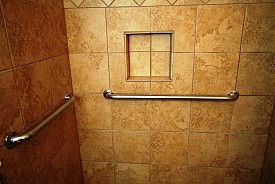10 Essential Bathroom Safety Tips for the Whole Family
 Did you know the most dangerous room in your house is the bathroom? More home accidents occur there than anywhere else, and family members of whatever age -- from newborns to 90-somethings -- may be at risk. Help ensure your loved ones' wellbeing with these 10 vital bathroom safety tips.
Did you know the most dangerous room in your house is the bathroom? More home accidents occur there than anywhere else, and family members of whatever age -- from newborns to 90-somethings -- may be at risk. Help ensure your loved ones' wellbeing with these 10 vital bathroom safety tips.
- Never, ever leave a small child unattended in the bath. Do not rely on bath seats, swim rings, or the like. Before bath time begins, set out all the supplies which you will need – shampoo, soap, towel, etc. – so that you can devote your full attention to your little one.
- Avoid the danger of scalding. Water is capable of burning just like fire; exposure to a temperature as low as 133 degrees F may result in third degree burns. Turn down the temperature of your water heater. Always check your baby or small child’s bathwater before helping them into the tub. Consider an anti-scald device or a digital faucet that remembers your preferred (safe) temperature.
- Install grab bars in the shower, tub, and toilet areas. These must be installed either vertically or horizontally, not diagonally and towel rails are not a sturdy enough substitute. And they’re not just for seniors -- 12 percent of all accidents occurring in the bathroom happen as people of any age are getting into and out of the shower or tub.
- Reduce the risk of slipping. Add non-skid strips to the tub bottom or if you are about to remodel your bathroom, install a tub or shower with builtin skid-proofing. Watch out for bath mats or rugs; these should also be slip-resistant. Laying smaller-size tiles, which require proportionally more grout, decreases floor slipperiness as well. Dry wet floors as quickly as possible.
- Always close and lock the toilet lid. It takes only a few extra seconds (especially if your toilet lock has an automatic reset function) and may save your toddler’s life. Young children are naturally curious and love to explore; unfortunately, they can drown in just a few inches of water.
- Store medications carefully. Keep in clearly marked containers, either the original packaging or a special pill dispenser. Never use the bottle from another medicine. Store in a locked cabinet separate from everyday items such as shampoo, soap, etc.
- Keep potentially poisonous cleaning products out of reach. Never place them in the undersink area. Even better, substitute non-toxic green cleansers like white vinegar and baking soda whenever possible. This all-natural “dynamic duo” does a fantastic job of descaling the showerhead, for example.
- Safeguard against electric shock. The 2014 National Electric Code mandates installation of GFCI (ground-fault circuit interrupter) protection on new or replacement outlets in all areas of the home close to a water source, like the kitchen counter, the laundry room, and, obviously, the bathroom. Hire an electrician and get this vital job done.
- Increase shower safety for any household member who has impaired mobility issues. Purchase a stable bath chair. Curbless shower installation will permit the person to enter with a wheelchair, walker, or other support.
- Prevent or treat mold. Your bathroom is a prime target for mold growth, due to the moisture in the air. Run the exhaust fan from before you step into the shower till 30 minutes afterward. Repair plumbing leaks promptly. If you spot mold or mildew in your bathroom (or even suspect its presence), call a professional for remediation. Mold can cause respiratory and other health problems, particularly in the very young, very old, or anyone with a compromised immune system.
Laura Firszt writes for networx.com.
Updated December 16, 2018.
Looking for a Pro? Call us (866) 441-6648

Electrical Average Costs
Electricians Experiences

Parking Lot Lights Restored So Employees Can Reach Cars Safely

Hardworking Handyman Brings Christmas To Southern California

Ceiling Collapse Caused By A Terrifyingly Negligent Contractor
Top Cities Covered by our Electricians
Austin
| Boston
| Charlotte
| Chicago
| Columbus
| Dallas
| Denver
| Detroit
| Fort Worth
| Houston
| Indianapolis
| Jacksonville
| Los Angeles
| Nashville
| New York
| Philadelphia
| Phoenix
| Portland
| San Antonio
| San Diego
| San Francisco
| San Jose
| Seattle
| Washington


